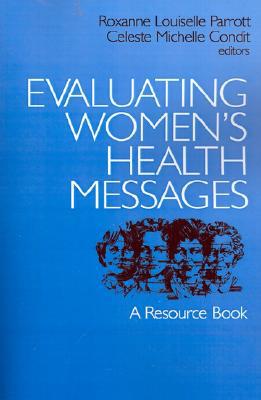Evaluating Women's Health Messages
The increased attention currently being paid to women's reproductive health issues has produced a corresponding interest in the role that communication plays in promoting better health care. Groundbreaking and comprehensive, this book is the first systematic examination of the major types and forms of messages about women's reproductive health - medical, social scientific and public - and the degree to which these messages compare with and contradict each other. Within the broad framework of...
Search in google:
The increased attention currently being paid to women's reproductive health issues has produced a corresponding interest in the role that communication plays in promoting better health care. Groundbreaking and comprehensive, this book is the first systematic examination of the major types and forms of messages about women's reproductive health - medical, social scientific and public - and the degree to which these messages compare with and contradict each other. Within the broad framework of communication, a range of women's health issues are examined in this book from political, historical, technological and feminist perspectives. The issues examined include: abortion; infertility; drug and alcohol use in pregnancy; childbirth; AIDS; and more. Helen M. Murphy This book examines medical, social research, and public messages about women's health. It analyzes the various modes of delivering messages to show consistencies, inconsistencies, and gaps in research and in our understanding of women's healthcare. It is intended to provide an overview of the pattern of gaps and biases in public media, campaign messages, and medical and social research/information about women's healthcare. The book is aimed at nonacademicians, media consumers of women's health messages, and academicians, students and health practitioners specializing in women's health, and in addition, those involved in the social sciences. The book has few illustrations, and those are black-and-white. Perhaps a little more attention here would have enhanced the book. On the other hand, the references are current, very pertinent, and come from a wide variety of sources. This is an excellent book. The subject matter is thoroughly and broadly researched by experts from a variety of U.S. universities and colleges. The content is presented in a unique, realistic, and relevant way, emphasizing the role politics and the media play in the process of constructing messages about women's healthcare. Moreover, a broad framework is used to outline the topic, including environmental, sociopolitical, and economic dimensions of women's healthcare messages. The book would be most useful for the well educated public, women's health advocacy groups, students and health practitioners specializing in women's health, in addition to social scientists. I highly recommend that libraries, bookstores, and individuals purchase it.
Preface1Introduction: Priorities and Agendas in Communicating About Women's Reproductive Health12Medical and Psychological Consequences of Legal Abortion in the United States173A Matter of Consequence: Abortion Rhetoric and Media Messages334Illicit Drug Use and the Pregnant Woman: Prevalence, Social Impact, Effects, and Legislative Action495The Drama of in Utero Drug Exposure: Fetus Takes First Billing616Contraception and Clinical Science: The Place of Women in Reproductive Technology817Our Bodies, Our Risk: Dilemmas in Contraceptive Information958The American Experience of Childbirth: Toward a Range of Safe Choices1099Contemporary Birthing Practices: Technology Over Humanity?12410Women and Smoking: Consequences and Solutions13911Tugging at Pregnant Consumers: Competing "Smoke!" "Don't Smoke!" Media Messages and Their Messengers15412Prenatal Alcohol Consumption and Outcomes for Children: A Review of the Literature17513Knowing When to Say When and Why: Media Messages Aimed at Preventing Women's Alcohol Consumption19014Promoting Prenatal and Pregnancy Care to Women: Promises, Pitfalls, and Pratfalls20515Prenatal Care From the Woman's Perspective: A Thematic Analysis of the Newspaper Media22216Cervical, Ovarian, and Uterine Cancer: Advancing Awareness, Choices, and Survival23417Magic, Moralism, and Marginalization: Media Coverage of Cervical, Ovarian, and Uterine Cancer24918Menarche, Menstruation, and Menopause: The Communication of Information and Social Support26519Media Portrayals of Women's Menstrual Health Issues27920Social Support and Breast Cancer: Why Do We Talk and to Whom Do We Talk?29321An Analysis of Discourse Promoting Mammography: Pain, Promise, and Prevention30722Options and Risks With Reproductive Technologies32723Media Bias for Reproductive Technologies34124Hysterectomies: Don't Ask "Why Not?" ... Ask "Why?"35625Hysterectomy: What the Popular Press Said (1986-1992)37026Women and AIDS: The Lost Population38227The Reconstruction of AIDS as a Women's Health Issue40228Conclusion: A Woman-Centered "Sense-Making" Approach to Communicating About Women's Reproductive Health414Index426About the Contributors439
\ Reviewer: Helen M. Murphy, MSN, MPH, RN(University of North Carolina-Chapel Hill School of Nursing)\ Description: This book examines medical, social research, and public messages about women's health. It analyzes the various modes of delivering messages to show consistencies, inconsistencies, and gaps in research and in our understanding of women's healthcare.\ Purpose: It is intended to provide an overview of the pattern of gaps and biases in public media, campaign messages, and medical and social research/information about women's healthcare.\ Audience: The book is aimed at nonacademicians, media consumers of women's health messages, and academicians, students and health practitioners specializing in women's health, and in addition, those involved in the social sciences.\ Features: The book has few illustrations, and those are black-and-white. Perhaps a little more attention here would have enhanced the book. On the other hand, the references are current, very pertinent, and come from a wide variety of sources.\ Assessment: This is an excellent book. The subject matter is thoroughly and broadly researched by experts from a variety of U.S. universities and colleges. The content is presented in a unique, realistic, and relevant way, emphasizing the role politics and the media play in the process of constructing messages about women's healthcare. Moreover, a broad framework is used to outline the topic, including environmental, sociopolitical, and economic dimensions of women's healthcare messages. The book would be most useful for the well educated public, women's health advocacy groups, students and health practitioners specializing in women's health, in addition to social scientists. I highly recommend that libraries, bookstores, and individuals purchase it.\ \ \ \ \ Helen M. MurphyThis book examines medical, social research, and public messages about women's health. It analyzes the various modes of delivering messages to show consistencies, inconsistencies, and gaps in research and in our understanding of women's healthcare. It is intended to provide an overview of the pattern of gaps and biases in public media, campaign messages, and medical and social research/information about women's healthcare. The book is aimed at nonacademicians, media consumers of women's health messages, and academicians, students and health practitioners specializing in women's health, and in addition, those involved in the social sciences. The book has few illustrations, and those are black-and-white. Perhaps a little more attention here would have enhanced the book. On the other hand, the references are current, very pertinent, and come from a wide variety of sources. This is an excellent book. The subject matter is thoroughly and broadly researched by experts from a variety of U.S. universities and colleges. The content is presented in a unique, realistic, and relevant way, emphasizing the role politics and the media play in the process of constructing messages about women's healthcare. Moreover, a broad framework is used to outline the topic, including environmental, sociopolitical, and economic dimensions of women's healthcare messages. The book would be most useful for the well educated public, women's health advocacy groups, students and health practitioners specializing in women's health, in addition to social scientists. I highly recommend that libraries, bookstores, and individuals purchase it.\ \ \ BooknewsExamines medical, social, scientific, and public messages about women's health, from various perspectives including feminist, historical, and political approaches. Look at issues such as abortion, AIDS, and menopause, summarizing medical and/or social scientific research and analyzing mass mediated messages women have received in recent years about medical research. For students in public health, health communication, and women's studies. Paper edition (unseen), $32.95. Annotation c. Book News, Inc., Portland, OR (booknews.com)\ \ \ \ \ 3 Stars from Doody\ \








